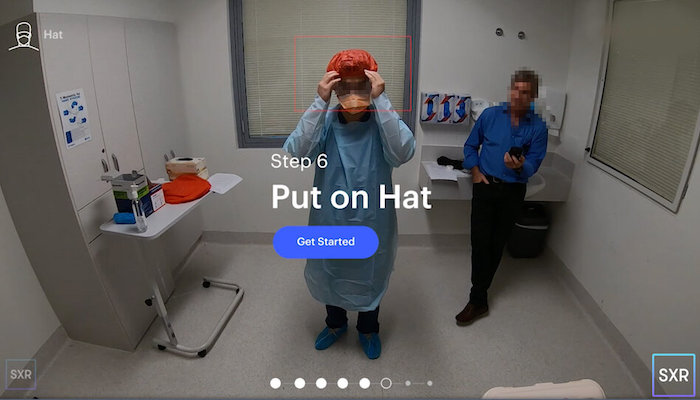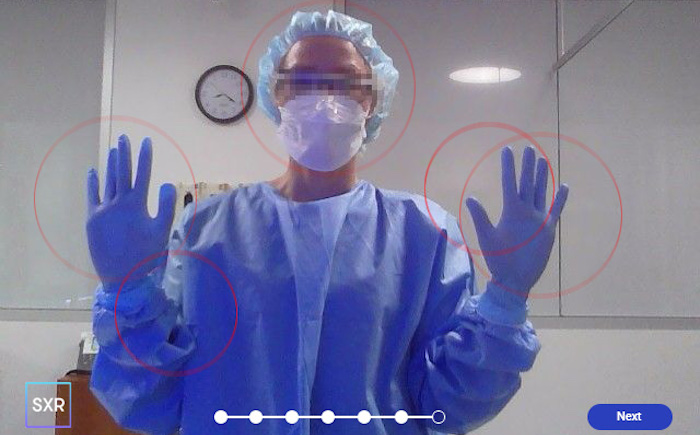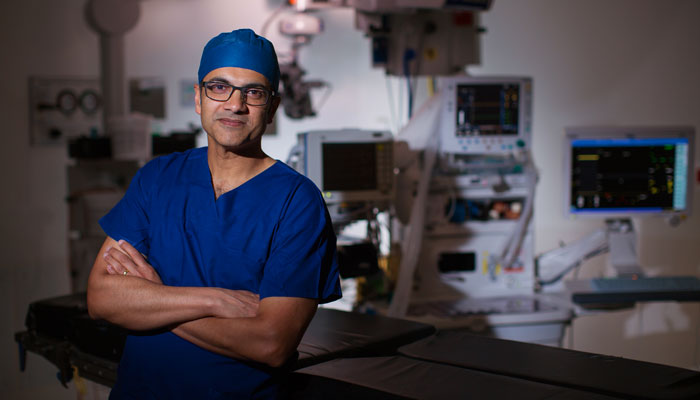A new app uses artificial intelligence to coach healthcare workers through safely putting on and taking off personal protective equipment (PPE) – and could help to reduce the spread of COVID-19 and other infectious diseases.

Time is now: PPE is the most reliable defence against the spread of infectious disease, making its effective use more important than ever.
The app was developed by Macquarie University cardiothoracic surgeon Professor Michael Wilson, in collaboration with software developer Terry Carney from Futureantics, and has been trialled at Macquarie University Hospital with medical students and nursing staff.
“For people working with potentially contagious patients, PPE is the most reliable defence against the spread of infectious disease,” says Wilson.
Outbreaks of the highly infectious Delta variant of COVID-19 have seen a number of Sydney hospitals recently close wards and send staff home to isolate, and Wilson says that Australia’s growing second wave of the pandemic highlights the need to be vigilant around infection-control protocols.
Unless you are putting on PPE daily, it’s easy to forget or overlook some of the different steps you need to go through.
“In a hospital setting, when you're looking after sick patients with COVID, PPE is the only method of preventing transmission via contact,” he says.
Wilson says it’s more important than ever that PPE is used effectively by people directly exposed to those who potentially have the disease.
The riskiest time
Anand Jayapadman is a final-year postgraduate medical student at Macquarie University and was involved in early trials of the software.

One step at a time: The app follows guidelines for correctly donning and doffing PPE that were developed in response to Ebola outbreaks.
“As medical students, we did get some training in how to put on and take off PPE before our hospital placements, but the pandemic really highlights how important it is to get it right,” he says.
“I got instructions from different people, and each time it was a little bit different – so that makes it difficult to remember and to feel confident that you are getting it right."
Jayapadman says that the advantage of the app was that the instructions are standardised and consistent – and he felt confident that every step he took would be checked along the way.
- Who is Douglas Grant? New film reveals hidden Aboriginal hero
- Hackers could bring down our cities: here's how we stop them
“You can’t see the germs, there’s no real way of knowing if you’ve protected yourself and the patient properly in this high-risk situation, without those visual checks, so having a standardised platform like this is so reassuring.”
While ‘buddy systems’ are in place in some workplaces, Jayapadman says it’s not always practical to have another staff member overseeing PPE, particularly when resources are stretched or limited, and the app could have great utility in regional areas.
Inexperience and exhaustion a lethal combination
“Unless you are putting on PPE daily, it’s easy to forget or overlook some of the different steps you need to go through,” says trainee doctor Alexandra Zacharakis, who has already done numerous hospital placements during her final year of medicine at Macquarie University.

Reassuring: The AI-PPE system is like having a second pair of eyes watching you and making sure you don't miss anything, says trainee doctor Alexandra Zacharakis.
The app identifies users through facial recognition, then guides them through the steps of the donning (putting on) or doffing (taking off) process, giving real-time feedback if there’s a potential breach along with relevant advice – for example, wash your hands for 20 seconds before going any further.
“The AI-PPE system is like having a second pair of eyes watching you and making sure you don't miss anything, it’s very reassuring, particularly if you’ve done a 12-hour shift and you’re really tired,” Zacharakis says.
Wilson says that there’s evidence that the biggest risk of a PPE breach to health professionals occurs when they remove (doff) contaminated PPE, a process that can involve 19 main steps.
How the software works
The US Centers for Disease Control and Prevention guidelines for correctly donning and doffing PPE were developed in response to Ebola outbreaks, and outline procedures for five levels of PPE, including for trained observers.
“A study at John Hopkins University analysed the potential for breaches in PPE based on human error and found more than 90 potential failure factors, which gave us a really useful basis for the AI software,” explains Wilson.
The team worked with the Macquarie University Simulation Centre for six months last year to adapt the SurgicalXR training platform to support a system to guide PPE protocol compliance.
“The complex artificial intelligence behind the system immediately converts moving images from a webcam to mathematically represent someone putting a mask on their face, and then feeds the relevant information back; for example – ‘You need to put your goggles on next’,” he says.
We’ve developed this system to be a really practical, useful aid for anyone working with potentially infectious people, rather than some Big Brother-style sentry.
With the assistance of Associate Professor Veronica Preda, the technology was trialled with students and some staff at Macquarie University Hospital and Medical School as part of a research project, with ethics approval, which will assess the effectiveness of the software in monitoring and improving compliance around PPE protocols.
Preda has now incorporated the app into the Macquarie University medical school curriculum and is helping co-ordinate access for other medical schools who have shown interest in using the app with their own students.
Wilson says the software is designed to become more accurate over time as it gathers more data – and includes tools which ‘scrub’ identifying details such as facial features from each frame of the video record, before storing data. “This gives us the capacity for a visual record that's privacy compliant.”
A future version could even collate errors and send a message to the user with information about the issues found in their donning or doffing process, to improve training and quality performance.
Future plans
The team plans to develop future iterations of the app that can be used on a subscription basis, perhaps on mobile phones or iPads, but the current version sits on a laptop which accesses the SurgicalXR AI-enhanced platform, which is hosted on an organisation’s main computer network.

Big picture: Professor Michael WIlson (pictured) says the app has the potential to standardise PPE protocols nationally.
“We’ve developed this system to be a really practical, useful aid for anyone working with potentially infectious people, rather than some Big Brother-style sentry,” says Wilson.
COVID-19 continues to pose a threat to people in front-line roles including ambulance and emergency services, pharmacies, GP practices and cleaners, and as more ‘variants of concern’ emerge, may be in high-volume use for years to come.
“PPE is now essential equipment for hotel quarantine staff and for people working in aged health care facilities, both workplaces that have a much higher incidence of people with a non-English speaking background who may not get thorough training in correct use of PPE."
Wilson says the app has potential to be rolled out to standardise PPE protocols nationally, and to train and reskill people across all health care sectors.
Professor Michael Wilson is a specialist in cardiothoracic surgery at Macquarie University Hospital.



